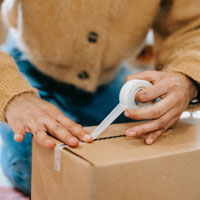5 Tips for Packing Boxes Securely for Shipping
 Whether you’re running an eCommerce business or sending a gift to a friend who lives across the country, it is important to pack the box securely to protect its contents and ensure they reach their destination in one piece. Let us offer a few tips on packing boxes securely for shipping.
Whether you’re running an eCommerce business or sending a gift to a friend who lives across the country, it is important to pack the box securely to protect its contents and ensure they reach their destination in one piece. Let us offer a few tips on packing boxes securely for shipping.
Tip #1. Choose a Sturdy Box
Choosing the right box for shipping is half the battle. Ideally, the box should be new but we understand that it is not always possible to get a new box for each shipment. You can reuse an old box if there are no other alternatives and the items you’re shipping are not fragile, but in this case you need to make sure that the box is only slightly used and undamaged. If you need more detailed advice on reusing boxes for shipping, you can find it here.
When choosing a shipping box, it is important to strike the right balance between reliability and weight. The box must be sturdy and strong enough to protect the objects inside, but it shouldn’t be too heavy. A regular cardboard box is okay if the objects you’re shipping aren’t heavy or breakable, but if you think that they need some extra protection, we recommend opting for a corrugated cardboard box. Such boxes are both sturdy and lightweight.
Tip #2. Make Sure the Box Is the Right Size
While it might be tempting to choose the smallest box possible to reduce your shipping costs (since postal and courier companies typically charge by dimensional weight), you should keep in mind that over-packing will most likely result in damage to the items you’re shipping because a) there will be no space left for protective cushioning and b) the contents of the box may turn out too heavy for it, and the box will burst open during transportation.
Under-packing is just as bad. When a box is too big for the items inside, they will jostle around despite protective cushioning and may get damaged during transportation. To pack your shipment securely, you must ensure that the box is just the right size to fit all the items you’re shipping and a moderate amount of protective cushioning.
Tip #3. Properly Arrange and Protect the Items Inside the Box
So, now that you’ve chosen the right box, you need to ensure that each item in the box is properly protected. If you’re shipping breakables, it is advisable to individually wrap each item in bubble wrap and secure it with packing tape. Once each item is protected, you can start arranging them inside the box.
Line the bottom of the box with cushioning material such as shredded or crumpled paper, packing peanuts, etc. Place heavier items on the bottom of the box, followed by lighter items on top. Fill the empty space inside the box with more cushioning material. Don’t forget to add a layer of padding on top before closing the box. Give the box a shake before sealing it. If you can hear the contents jostle inside, add some more cushioning before taping the box shut.
Tip #4. Use the Right Packing Tape
Choosing the right kind of packing tape is just as important as choosing the right box. Basic duct or masking tape won’t do, but there are four main types of specialized packing tape for you to choose from. When shipping low-cost packages, you can opt for plastic packing tape because it’s reliable enough and at the same time affordable. If you need a little extra protection, consider using vinyl or reinforced packing tape. Finally, gummed packing tape is both more reliable and more eco-friendly than the other three options, but it is also more expensive and requires using a special dispenser.
When sealing the top and the bottom of the box shut, make sure the packing tape extends over its sides a couple of inches. It will hopefully keep the box from bursting open if it gets handled improperly during transportation.
Tip #5. Make Sure to Label Your Shipment Properly
If you print shipping labels yourself, make sure you use the ink that won’t smear, protect the shipping label from the elements (for example, by placing it in a clear address pouch), and securely attach it to the address side of the package. It is also a good idea to include an extra copy of the shipping label inside the package in case the label on the box gets unreadable or damaged while in transit.
When shipping fragile items or hazardous products, make sure that the box is labeled accordingly (and, in case of hazardous products, that you have all required permits and documentation).